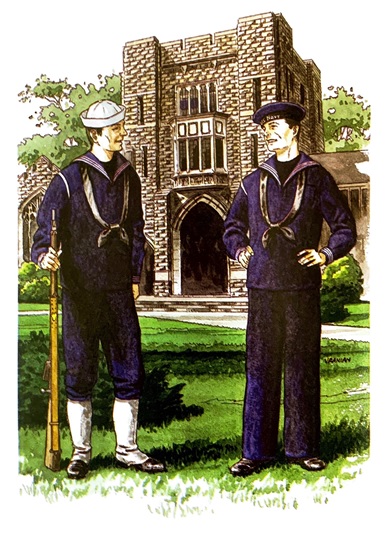Like their Army counterparts in regular SATC units, members of Navy and Marine Corps SATC units received military training and took academic classes. They took the War Issues course and participated in the required 11 hours per week of military training. Where they differed was in the academic courses the Navy and Marines recommended and the types of specialties they were looking to recruit from the SATC units.

SATC Marine Units
Members of SATC Marine units were offered two roles to prepare for; infantry officer or aviator. For those wishing to become infantry officers, the Marine Corps ordered that these men were to “follow, in general, the same course of instruction and training as outlined for the Student Army Training Corps by the War Department and the Commanding Officer of the college organization.”2 Presumably, this meant that they would take the same courses as prescribed in Group I: Program A, which included the War Issues Course, Military Law and Practice, and Surveying and Map-Making.3
Those wishing to become aviators and join the Marine Corps Reserve Flying Corps faced more stringent requirements. Unlike their Army counterparts applying to the Air Service, the Marine Corps required more mathematical instruction for SATC members. SATC applicants for the Marine Corps Reserve Flying Corps must have successfully completed Elements of Algebra, Plane Geometry, Solid Geometry, Trigonometry, and Physics in order to be considered. In addition to these academic requirements, the Marine Corps also had physical requirements including being between 19 and 33 years old, between 130 and 170 pounds, taller than 5′ 4″, and perfect 20/20 vision without glasses.4
Instructions to Officers in Charge of Marine Corps Sections of Student Army Training Corps
SATC Naval Units
In general, the Committee on Education and Special Training (CEST) recommended that Navy SATC students follow the Mechanical Engineering course as outlined for all other SATC units. Having more sailors with mechanical engineering knowledge would be helpful for the Navy, given the increasingly large role naval power was playing during World War I.6

However, the CEST did make exceptions for those that wanted to serve in the Paymaster Corps, Naval Air Service, or as deck officers. Those wishing to enter the Paymaster Corps were expected to take Economic based courses, including Accounting and Business Management. SATC students who wanted to join the Naval Air Service were expected to take Map-Reading and Navigation. Those who wanted to serve as deck officers were given a recommended program to follow, but were not bound to it. The program included the mandatory 11 hours per week of military training and the War Issues course, but emphasized mathematics, physics, and foreign languages.8

Special Bulletin on Program for Naval Sections
Notes:
- University of Virginia Naval Unit Student Army Training Corps Photograph, 1918, Accession # RG-30/1/1.992, Special Collections, University of Virginia Library, Charlottesville, VA.
- Instructions to Officers in Charge of Marine Corps Sections of Student Army Training Corps, 4, Box SF047, Folder SATC Correspondence 1918 May, World War I Students’ Army Training Corps (SATC) and Training Camps Records, 1917-1919, Office of the Superintendent, administrative subject files, Virginia Military Institute Archives, Lexington, VA.
- Memo from the Committee on Education and Special Training to Colleges having units (Collegiate Sections) of the Student Army Training Corps dated September 18, 1918, 4-6, Box 3, Folder 8, Records of the Dean of the College, Theodorick Pryor Campbell, RG 11/1, Special Collections and University Archives, Virginia Tech, Blacksburg, VA.
- Instructions to Officers in Charge of Marine Corps Sections of Student Army Training Corps, 3, Box SF047, Folder SATC Correspondence 1918 May, World War I Students’ Army Training Corps (SATC) and Training Camps Records, 1917-1919, Office of the Superintendent, administrative subject files, Virginia Military Institute Archives, Lexington, VA.
- Instructions to Officers in Charge of Marine Corps Sections of Student Army Training Corps, Box SF047, Folder SATC Correspondence 1918 May, World War I Students’ Army Training Corps (SATC) and Training Camps Records, 1917-1919, Office of the Superintendent, administrative subject files, Virginia Military Institute Archives, Lexington, VA.
- Special Bulletin on Program for Naval Studies, Box 3, Folder 5, Records of the Dean of the College, Theodorick Pryor Campbell, RG 11/1, Special Collections and University Archives, Virginia Tech, Blacksburg, VA.
- Harry Downing Temple, The Bugle’s Echo: A Chronology of Cadet Life at the Military College at Blacksburg, Virginia, The Virginia Polytechnic Institute, vol. III (1912-1920) (Blacksburg, VA: The Virginia Tech Corps of Cadets, Inc., 1998), 2138.
- Special Bulletin on Program for Naval Studies, Box 3, Folder 5, Records of the Dean of the College, Theodorick Pryor Campbell, RG 11/1, Special Collections and University Archives, Virginia Tech, Blacksburg, VA.
- Special Bulletin on Program for Naval Studies, Box 3, Folder 5, Records of the Dean of the College, Theodorick Pryor Campbell, RG 11/1, Special Collections and University Archives, Virginia Tech, Blacksburg, VA.
- Special Bulletin on Program for Naval Studies, Box 3, Folder 5, Records of the Dean of the College, Theodorick Pryor Campbell, RG 11/1, Special Collections and University Archives, Virginia Tech, Blacksburg, VA.